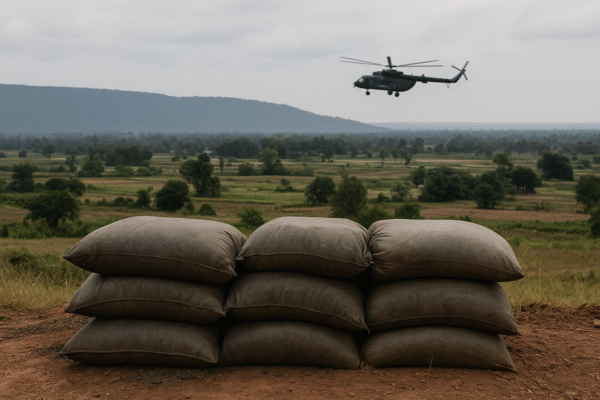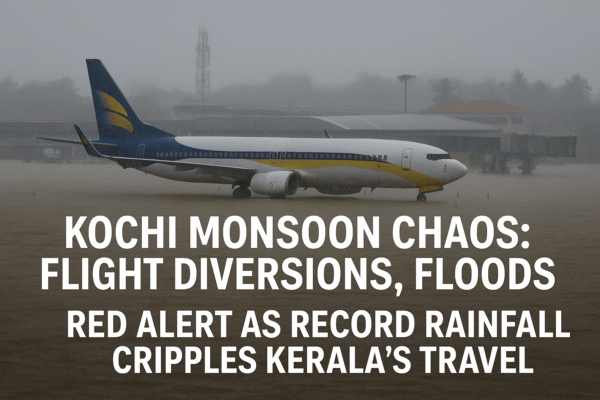Kochi, India – July 27, 2025 — The southern Indian city of Kochi is reeling under the impact of record-breaking monsoon rainfall, which has flooded streets, disrupted flight operations, and forced emergency alerts across the Ernakulam district. Over the weekend, torrential rain submerged Cochin International Airport’s tarmac, diverted major domestic flights, and left both locals and travelers stranded amid collapsing drainage, swelling rivers, and waterlogged homes.
According to the India Meteorological Department (IMD), Kerala received over 150mm of rain in 24 hours—well above the seasonal average. The persistent downpour prompted a rare red alert, cautioning residents about the high probability of landslides, flash floods, and stormwater surges.
Multiple Flights Diverted Amid Zero Visibility at Kochi Airport
Flight operations were among the first casualties of the downpour. Cochin International Airport (COK), a key aviation hub for southern India, witnessed dramatic scenes as ground staff ferried passengers through waist-high water. At least three major flights were diverted:
- Akasa Air from Mumbai – Scheduled arrival at 11:15 a.m.
- Alliance Air from Agatti – Rerouted at 11:45 a.m.
- IndiGo Flight 6E from Mumbai – Forced to turn back at 12:50 p.m.
Runway visibility dropped below safe landing thresholds, while crosswinds and lightning further complicated operations. Airport authorities suspended select operations as a safety measure, and travelers were advised to monitor real-time updates via airline apps and government aviation platforms.
Red Alert Issued as Kerala Faces Landslide and Flood Threats
By Saturday evening, the Ernakulam District Collector activated emergency protocols and enforced a ban on night travel in hilly and forested areas. The IMD warning pointed to further rainfall in the next 48 hours, raising concerns about soil erosion and slope collapses in the Western Ghats.
Key water bodies like the Periyar and Chalakudy rivers are flowing dangerously close to their flood thresholds. Officials have issued warnings to residents in Aluva, Kalady, and Chalakudy to evacuate if necessary.
In response, over 30 mobile rescue units have been deployed to rural blocks, equipped with boats and emergency relief kits. The Kerala State Disaster Management Authority (KSDMA) has also set up public helplines and emergency response zones for flood-prone areas.
Inner Kochi Suffers Major Urban Flooding and Gridlock
In urban Kochi, business districts like MG Road, Edappally, and Vyttila were submerged by midday. Long traffic jams and waterlogged public transport hubs created a bottleneck that paralyzed the city. The Ernakulam KSRTC bus terminal was partially flooded, while the South railway station faced temporary closures of some platforms due to standing water.
Kochi’s aging stormwater systems, already under pressure from rapid urban development and unregulated construction, were unable to cope with the sudden volume. City engineers are racing against time to deploy pumps and reroute drainage flows before more rainfall hits.
Coastal Regions Hit by Rough Tides and Seawater Intrusion
The situation was no better along the coast. Villages like Chellanam, Edavanakad, and Aniyal Beach saw tidal waves breach sea walls, flooding homes and contaminating drinking water sources. The combined effect of high tide and monsoon swell resulted in saltwater flooding, damaging interiors and displacing at least 60 families by Saturday night.
Temporary shelters have been opened in municipal schools and community halls, while sandbag reinforcements are being laid along vulnerable stretches of the coast. Fisherfolk have been advised to avoid venturing into the Arabian Sea as gusty winds and high waves continue.
Nearly 20 Homes Damaged; Hundreds at Risk
Damage reports compiled by local panchayats and the KSDMA show that 19 homes were partially damaged in the past 48 hours—10 on Saturday and 9 on Friday. These include roof collapses, wall fractures, and submerged ground floors. The overall monsoon damage tally for Kerala now stands at 336 homes, including 8 declared fully uninhabitable.
Tarpaulins, food packets, and clean water are being distributed in affected wards, with medical teams monitoring sanitation conditions to prevent outbreaks of waterborne diseases.
Rivers and Dams Nearing Overflow
The Edamalayar and Malankara dams are both nearing maximum capacity, triggering flood-control measures. Officials from Kerala’s Water Resources Department are closely monitoring reservoir inflow and have prepared contingency plans for controlled water release if rainfall persists.
As upstream rivers like the Muvattupuzha and Chalakudy continue to swell, low-lying towns downstream are under close watch. Residents are advised to move essential goods to higher levels and stay connected to district administration updates.
Trees Uprooted, Power Lines Down Across City
Adding to the misery were incidents of tree falls across Kochi suburbs, blocking arterial roads and disrupting power lines. In Kalamassery and Thrikkakara, fire and rescue teams worked overnight to clear debris. Widespread power outages were reported, with KSEB crews struggling to restore supply amid flooded transformer zones.
Conclusion: Kochi Braces for More Rain as Crisis Deepens
The monsoon deluge in Kochi has exposed critical weaknesses in urban infrastructure and climate resilience. As more rain is forecast into the new week, officials warn of a prolonged emergency that could stretch resources and test the city’s preparedness.
Passengers traveling to or from Kochi are urged to check flight statuses before departure, avoid low-lying routes, and follow Kerala government advisories. Emergency shelters, food distribution points, and medical assistance remain active across the district.
For more travel news like this, keep reading Global Travel Wire





















